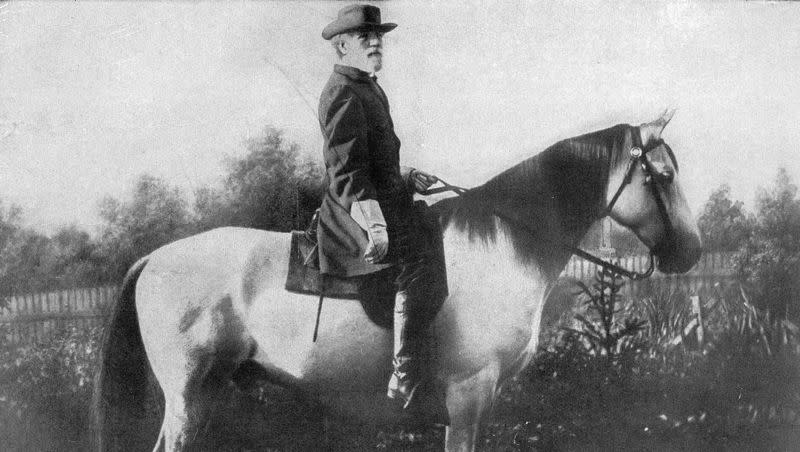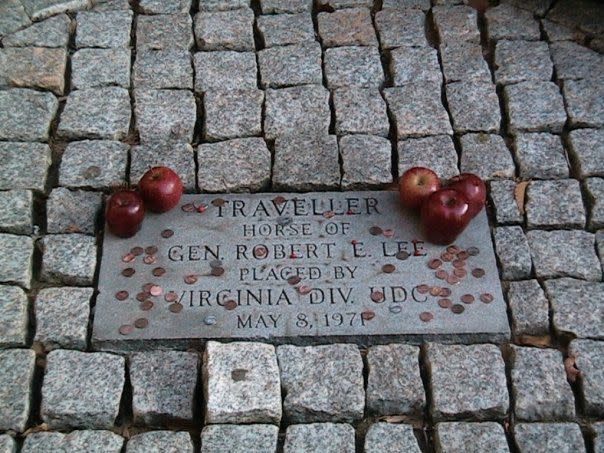Has cancel culture really come for a horse?

According to a student publication at Washington and Lee University in Virginia, cancel culture has come for a horse: Traveller, the gray Saddlebred that was a favorite mount of Confederate Gen. Robert E. Lee.
Citing confidential sources, the W&L Spectator last month published photographs and a video that the student journalists said showed the removal of plaques honoring the horse. One was at Traveller’s grave.
Another plaque, which was on a brick building that was formerly a stable, said: “The last home of Traveller. Through war and peace the faithful, devoted and beloved horse of General Robert Lee. Placed by the Virginia Division, United Daughters of the Confederacy.”
According to The W&L Spectator, “Every president since Robert E. Lee has lived in the house and used its stables as their garage. Campus tradition dictates that the doors to the stable must remain open for the ghost of Traveller to come and go at will.”
Traveller was euthanized in 1871, a year after his owner’s death; the horse contracted equine tetanus from what was believed to be a rusty nail. For a time, his skeletal remains were on display, but they are now buried outside a university chapel and museum.
The marker at the gravesite once looked like this:

According to the student publication, the grave now only bears the name of the horse, and the years of his birth and death.
After a 24 hour blitz, university officials have removed and replaced Traveller’s headstone with a new one lacking historical context.
Photo Credit: Anonymous pic.twitter.com/vFl6D5m54U— The W&L Spectator (@wluspectator) July 15, 2023
Of course, this isn’t really a case of “cancel culture,” in which there is an attempt to damage the reputation or livelihood of a person (or horse) because of something they said or did.
Evan Nierman, the author of “The Cancel Culture Curse,” defines cancellation as “the use of intimidation by a morally absolute coalition to isolate and disproportionately punish an alleged transgressor.” The attempted cancellation of the Budweiser Clydesdales earlier this year more aptly fits that bill.
The debate over how Traveller will be represented on the grounds of the university, if at all, is of a much more serious nature.
A university spokesman told the student journalists last month that the plaques were being relocated to a new permanent exhibit set to open this fall. Another said the campus was in the midst of “ongoing construction projects — including those in University Chapel.”
There is, of course, no way to separate the horse’s fame from that of his owner, who rode Traveller in multiple battles, and also rode him home after surrendering at Appomattox. And Lee, despite his post-war efforts to reunite the country, is persona non grata in much of America today.
In 2021, the university’s board voted to preserve its name despite calls from students and faculty to drop the “Lee.” The school is named for both George Washington and Lee, who was president of what was then called Washington College from 1865 to 1870.
Lee is buried underneath the chapel, near his beloved horse. The chapel was once named for Lee, but has since been renamed University Chapel, amid ongoing controversy over posthumous honors given leaders of the Confederacy.
Related
Opinion: It is well past time to take down Confederate statues
Bison now in place where Confederate statue once stood at Dixie State University
Virginia has been at the center of numerous controversies, including the removal of Confederate monuments in Richmond, in a push that began after the murder of nine African Americans at a church in Charleston, South Carolina, in 2015, and was renewed after the killing of George Floyd in 2020.
Writing on the Traveller controversy, George Washington University Law School professor Jonathan Turley said, “The preserving of such memorials allows for the public to see the full historical continuum, including the painful chapters in that history.”
But, he added, “It can never be forgotten that Lee fought for the South in a struggle against slavery. The stain of slavery in our history is indelible and painful for all of us. However, we can reflect that contextual history and preserve the history ... and spare the horse.”

